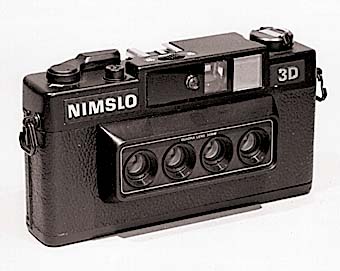
| Overview |

THE Museum of the History of Science has a small but fine collection of cameras, early photographic lenses and accessories, and darkroom equipment. In all there are about eight hundred items covering a wide spectrum of photographic history, from a lens of 1839 of the type used by Louis Jacques Mandé Daguerre (Item 118) to an example of a 1960s Russian 'FED 4' camera (Item 99) and beyond. Rare cameras with specialist uses - such as the Sutton panoramic camera of circa 1861 with its characteristic bulbous glass-and-water lens (Item 52) - are amongst those represented as well as mass-produced models such as the Kodak Instamatic of 1966, one of the first cartridge-film cameras (Item 96).
Two of the earliest devices on show are a solar microscope (Item 18) and a large folding camera obscura (Item 2). Both were first used by artists and draughtsmen as aids to drawing before being applied to early photographic experiments - William Henry Fox Talbot, the English pioneer of photography, for example, used the solar microscope for some early attempts at 'photogenic drawing' (see Item 65). However, there were a number of problems associated with using such devices to take photographs, not least that of getting sufficient light to the light-sensitive material to produce any image at all, as is amply illustrated by the very faint image only just visible in a photogenic drawing made by Robert Hunt in 1839 using the camera obscura (Item 66). In order to get around such problems, Daguerre devised the 'photographic' camera, based on the sliding-box portable camera obscura but with an improved lens of large enough aperture to enable 'the light to do the drawing' through its action on silver-based chemicals. On display is an early French example made in about 1845 with a lens by Lerebours & Secretan of Paris (Item 19). Other cameras on display are representative of subsequent technical developments in the history of photography. The early 'stand' cameras - so called because they had to be supported on a tripod or some other rigid support - such as the impressive wet-plate folding box-camera, c. 1855, with lenses by the London optician Ross (Item 3), were cumbersome affairs. Gradually they became supplanted by more portable forms. The first 'hand' cameras appeared in the 1890s after the introduction of faster emulsions and shutters. A typical example is the Century field camera (Item 22) from around 1900. It is a dry plate camera and its lens has a shutter based on a popular design introduced by Bausch & Lomb in 1897 and later taken over by Kodak (see Item 135).Facilitated in part by the introduction of transparent, celluloid-based roll-film by Eastman in 1889, cheaper, mass-produced portable cameras also began to be marketed. Examples in the collection include a No. 2 Kodak box camera of 1890 (Item 28), representing the change from plate to rollfilm; a Kodak 'Brownie' (Item 34), named after a character in a children's book; a Zeiss Ikon Contax Ia of c. 1933 (Item 97), the earliest of the Museum's 35mm cameras; and a Kodak Retina I of 1946 (Item 98).
As far as the introduction of shutters is concerned, the first photographers made exposures simply by removing and replacing the camera's lens cap. The early shutters in the exhibition, such as the drop, flap and roller-blind shutters (Items 129 to 134), were sold separately from cameras and in most cases were fitted in front of the lens. Self-capping shutters (Item 135 and 136), which were always closed except when the shutter was triggered, were introduced in the 1880s for the new hand-held and 'detective' cameras. Their simplicity of operation was an important selling point and since they made it impossible to use the ground-glass screen at the back of the camera for focusing and composition, they prompted the widespread use of separate viewfinders.
After the introduction of faster emulsions, correct calculation of exposure also became increasingly important. As the new materials were manufactured under controlled factory conditions, exposure times could be predicted more easily, with the aid of exposure guides and exposure meters. Before the advent of the photoelectric meter in the 1930s, the two most popular aids to calculating exposure were tint-meters, such as the popular Watkin's 'Bee meter' (Item 140) which depended on the measurement of the time taken for sensitive paper to darken to a standard tint, and optical exposure meters, or 'extinction' meters, such as Decoudun's photometer (Item 141).
The development of stereoscopic cameras is particularly well represented by the Museum's collection. Stereoscopic photographs date from as early as 1841; the earliest stereoscopic camera on display is a sliding-box, monocular stereoscopic camera by Dallmeyer, c. 1862 (Item 43). In this camera the stereo pair of photographs was produced by making two separate exposures and sliding the lens panel, which had only a single lens, from left to right over the camera body which was divided intern ally into two compartments. The most recent stereoscopic camera represented is a Nimslo 'three-dimensional' camera of the early 1980s. This took not two but four pictures, simultaneously, on 35mm film (Item 51). The exposed film had to be returned to Nimslo for processing and printing by a special technique to achieve the stereoscopic effect. It was not a commercial success.
Several items in the exhibition are notable because of their links with famous or important people: two astronomical cameras and a dark-slide carrier made in about 1854 for the astronomer Warren De la Rue for photographing the moon (Item 54, 55 and 56); the wet-collodion photography outfit of the Reverend Charles Dodgson, alias Lewis Carroll (Item 8); the camera used for early colour photography by the Oxford resident Sarah Angelina Acland (Item 148); and the archaeological camera made in 1910 for T. E. Lawrence - better known as Lawrence of Arabia - and used by him to record the excavations made at Carchemish in Syria in 1911 (Item 57).